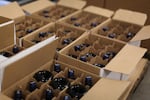Oregon’s groundbreaking Bottle Bill is approaching its 50th anniversary next year — an occasion that may be marked with a revamp to keep up with industry changes and to do a better job meeting environmental policy goals.
The Oregon Audits Division on Tuesday released its assessment of how well the landmark program is working, along with a list of recommendations that will help modernize the program and create more incentives for the public to recycle. The recommendations were delivered to the Oregon Liquor Control Commission, which oversees the Bottle Bill’s implementation. They call for a range of actions, like adding wine and liquor to the list of beverages covered by the Bottle Bill and automatically boosting the deposit by a nickel whenever redemption rates fail to hit certain targets.

New recommendations for updating Oregon's Bottle Bill include subjecting wine bottles to a redeemable deposit. Currently the deposit is 10 cents per container. It applies to beer, soda and water cans and bottles.
Dave Blanchard / OPB
Another recommended change would shift some or all of the revenue from unredeemed deposits to the state to help pay for environmental or recycling programs. Some of that revenue — from the dime-per-container fee that consumers pay when they buy soft drinks, beer or bottled water but fail to recoup by returning their empties and cashing in the refund — currently goes to beverage distributors or the industry-backed Oregon Beverage Recycling Cooperative.
Oregon’s Bottle Bill was the first of its kind and passed in 1971 to address a growing litter problem in public areas. Nine other states followed suit and created their own bottle bill programs. Now, after nearly 50 years that have seen several innovations within the beverage industry and consumer choices, the legislation is ripe for an update.
About 2 billion beverage containers are sold each year in Oregon. With a 10-cent fee, consumers end up paying about $200 million in deposits.
In 2019, nearly $31 million of that deposit money went unredeemed. Some of those unredeemed funds or deposits came from consumers who use a BottleDrop facility operated by the industry-backed Oregon Beverage Recycling Cooperative. Participants can create an account and use the program’s green plastic bags to gather up their containers and drop them off in bulk, rather than feed them, bottle-by-bottle and can-by-can, into redemption machines.
Audit Manager Ian Green said many consumers who set up BottleDrop accounts have positive balances that have not been active for three years. Those balances could be considered unclaimed property under Oregon law.
He said one of the agency’s recommendations is for the OLCC and the Department of State Lands to work together to collect those unredeemed funds on behalf of the state and help environmental or recycling programs.
Another notable recommendation is expanding the program to include wine and liquor sales. According to the audit, it’s likely these beverages are the largest remaining category of containers not currently included in the law, except for milk and milk substitutes, like soy- or oat-based milk and creamers.
There are approximately 100 million wine and liquor containers sold in Oregon each year and Green said with a 10-cent deposit that would generate about $10 million in additional deposits.
OLCC’s Alcohol Spokesperson Bryant Haley said the OLCC’s job is to educate the public about the program and making sure retailers are following rules in taking containers back.
“Recently, we’ve gone to see the change to the 10 cents per bottle as well as we’ve seen an increase in the amount of ways in which consumers can return bottles,” Haley said. “This is another step in refining that program and continuing to build out Oregon’s ability for consumers to return and keep some products out of the waste system.”
Haley also gives credit to the agency’s partnership with OBRC, as working together has helped OLCC and the cooperative in learning about trends and new issues that arise like determining if hard seltzer qualifies in the program.
“All these little things as the market shifts and evolves, how do we respond to that?” he said. “What is milk? Is it nondairy products? You know with the oat milks and all that in the market that we weren’t even familiar with several years ago that have now grown in popularity.”
Haley said these recommendations will be explored more by the industry and state lawmakers during the 2021 legislative session.
OBRC’s chief stewardship officer and director of external relations, Jules Bailey, said the current Bottle Bill system in Oregon is working just fine. The cooperative is open to having conversations about the recommendations and where to improve the program, but he took exception to the Audits Division’s recommended shift of some unredeemed bottle and can deposits from the industry to state environmental programs. He also warned that his organization would take on increased costs from processing wine and liquor containers that would outstrip the benefits.
“We have the best run system in the nation,” he said. “We have one of the highest if not the highest redemption rate in the nation and frankly, a lot of other states are looking to Oregon to see how they can be more like us as opposed to our system looking more like theirs.”
Bailey also said that the state Audits Division’s $31 million figure for the value of unredeemed deposits in 2019 is incorrect — and that by using this figure the state is overstating the program’s capacity to shift revenues to public agencies without turning to taxpayers to cover the resulting underfunding of the bottle-return system that OBRC operates.
